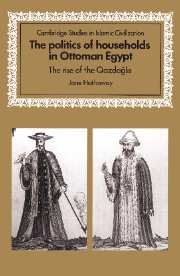Book contents
- Frontmatter
- Contents
- Note on transliteration
- List of illustrations
- List of tables
- Preface
- List of abbreviations
- Genealogical tables
- Introduction
- I The household and its place in Ottoman Egypt's history
- II Qazdağli household-building strategies
- Chapter 6 Marriage alliances and the role of women in the household
- Chapter 7 Property and commercial partnerships
- Chapter 8 The Qazdağlis and the Chief Black Eunuch
- Chapter 9 Conclusions
- Glossary
- Bibliography
- Index
Chapter 7 - Property and commercial partnerships
Published online by Cambridge University Press: 22 September 2009
- Frontmatter
- Contents
- Note on transliteration
- List of illustrations
- List of tables
- Preface
- List of abbreviations
- Genealogical tables
- Introduction
- I The household and its place in Ottoman Egypt's history
- II Qazdağli household-building strategies
- Chapter 6 Marriage alliances and the role of women in the household
- Chapter 7 Property and commercial partnerships
- Chapter 8 The Qazdağlis and the Chief Black Eunuch
- Chapter 9 Conclusions
- Glossary
- Bibliography
- Index
Summary
Building a household entailed not only acquiring clients and forging alliances, by marriage or otherwise, but also amassing enough wealth to sustain these clients, along with wives and children, and to leave a legacy that they could inherit. Hence a prime concern of any astute grandee was securing a steady source of revenue. This revenue could derive from tax-collection rights in both city and countryside, from property rentals, or from investment in trade. Complementing and reinforcing this tangible wealth was the household's symbolic wealth: monuments to a household's stature in the form of maʾāthir – the charitable works, such as mosques and fountains, that a household head commissioned – or, more fundamentally, the mansion or palace where the household assembled to hatch its schemes of aggrandizement. Such structures proclaimed the household's existence and contributed to its members' sense of identity and cohesion.
The house
Perhaps the most visible and essential component of a household's wealth was the house that it used as a headquarters. Indeed, the very ability to purchase or commission the construction of a palatial residence reflected a certain degree of wealth, status, and independence on the part of the household head. Household heads of relatively low status, such as low-ranking regimental officers, tended to use their barracks in Cairo's citadel as a headquarters while perhaps maintaining modest family residences in various neighborhoods.
- Type
- Chapter
- Information
- The Politics of Households in Ottoman EgyptThe Rise of the Qazdaglis, pp. 125 - 138Publisher: Cambridge University PressPrint publication year: 1996



